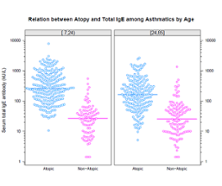The safetyGraphics R package now supports custom workflows allowing users to preload their own charts and data sets in the safetyGraphics Shiny Application. The best way to learn more is the new Custom Workflows vignette - which has been briefly summarized below.
Text Mining in Asthma, Allergy and Immunology - Part 1 of 2
In the field of clinical research, many important deliverables exist in the format of a PDF or other text-based document. Examples range from Protocols, SAPs, and CRFs to Manuals and Reports. These documents are essential for guiding research and disseminating results, but Researchers already derive great value from these documents as they read and reference them throughout the life of a study. But what if we could extract even more value from these same resources, even long after a study has been completed? This idea motivated our interest in text mining, which is an extensive analytical domain centered on deriving quality information from text documents. To showcase our explorations into the world of text mining, we present this blog post focusing on some of the simpler techniques we applied to study protocols.
Head in the (Word) Clouds, Feet on the Ground
One of the teams I used to work on at my company had a tradition of creating friendly little word clouds that they would printout and give to team members on their birthday. They were easy to make, and a fun alternative to the standard birthday card, but I never gave word clouds much serious thought as a data visualization tool. To me, they were merely a fun diversion and a nice decoration to liven up my drab cubicle walls.
CRANsearcher - R package discovery made simple
It’s a familiar story to many of us: we’re working along and find that we need something very specific. It could be a function or macro, or maybe an analysis technique. It’s also probably going to be quite difficult to create from scratch. So we wonder, maybe this has been done before?
Make GitHub Your Code Repository
This post shares information from our presentation at this year’s PhUSE Connect conference. The paper and slides from this project and others are available in our Publications Library
safetyGraphics Version 1.0
We’re excited to report that the safetyGraphics R package is now officially out of Beta! Version 1.0 of the package has been released on github and sent to CRAN. Try it here!
Relaunching the Rho Graphics Website
Our team is all about developing open-source tools, so we do lots of our work in public. Yet we’ve been pretty bad about maintaining a decent public website in recent years. That ends today! We’re happy to announce the launch of the new Rho Graphics website.
Embracing Open Source as Good Science
 Sharing. It’s one of the earliest lessons your parents try to teach you - don’t hoard, take turns, be generous. Sharing is a great lesson for life. Sharing is also a driving force behind scientific progress and software development. Science and software rely on communal principles of transparency, knowledge exchange, reproducibility, and mutual benefit.
Sharing. It’s one of the earliest lessons your parents try to teach you - don’t hoard, take turns, be generous. Sharing is a great lesson for life. Sharing is also a driving force behind scientific progress and software development. Science and software rely on communal principles of transparency, knowledge exchange, reproducibility, and mutual benefit.
safetyGraphics R Library released to CRAN
We’re excited to report that the safetyGraphics R package is now on CRAN! safetyGraphics is designed to make it easy to create interactive graphics related to clinical trial safety. We’re still in beta, but are very excited about the progress so far - here’s a sneak peek:
Interactive Adverse Events Explorer
In the conduct of clinical trials, few tasks are as important as monitoring and reporting adverse events (AEs). The standard method of reporting AEs is to compile detailed listings of every adverse event reported in a study. Medical monitors and regulatory bodies are then tasked with reviewing these listings to monitor patient safety and search for complications and side effects associated with an investigational product.
Introducing Rho Data Visualization
We work in clinical research and our industry is driven by data. Every phase of our trials requires us to collect, monitor, analyze, and report data. While each of these steps is equally important, reporting is arguably the most impactful step. When we create reports, we invite our audience to interpret the data and draw meaningful conclusions.
 Is the trial being conducted correctly? Is participant enrollment on schedule? Are we protecting our participants’ safety? Was the investigational product effective? Was our hypothesis confirmed? We rely on effective data reporting to answer these questions.
Is the trial being conducted correctly? Is participant enrollment on schedule? Are we protecting our participants’ safety? Was the investigational product effective? Was our hypothesis confirmed? We rely on effective data reporting to answer these questions.
Unfortunately, our industry doesn’t always use the best tools or practices when it comes to data reporting. If you’ve ever had to make sense of 50 pages of data listings or spend hours creating figures using spreadsheet software, you know what we mean. If these methods feel outdated, it’s because they are. The good news is that there are plenty of alternatives available to us, and in recent years, important stakeholders in our field have acknowledged our need to branch out, adapt, and evolve.
Granted, some of the formats for reporting are mandated by formal regulations. We may not be able to do much about these reports, but many of the methods we use to report data are left up to us as analysts and data scientists. As such, we argue that clinical researchers have a responsibility to do the data justice and communicate them as clearly and effectively as possible.
 Graphics
Graphics